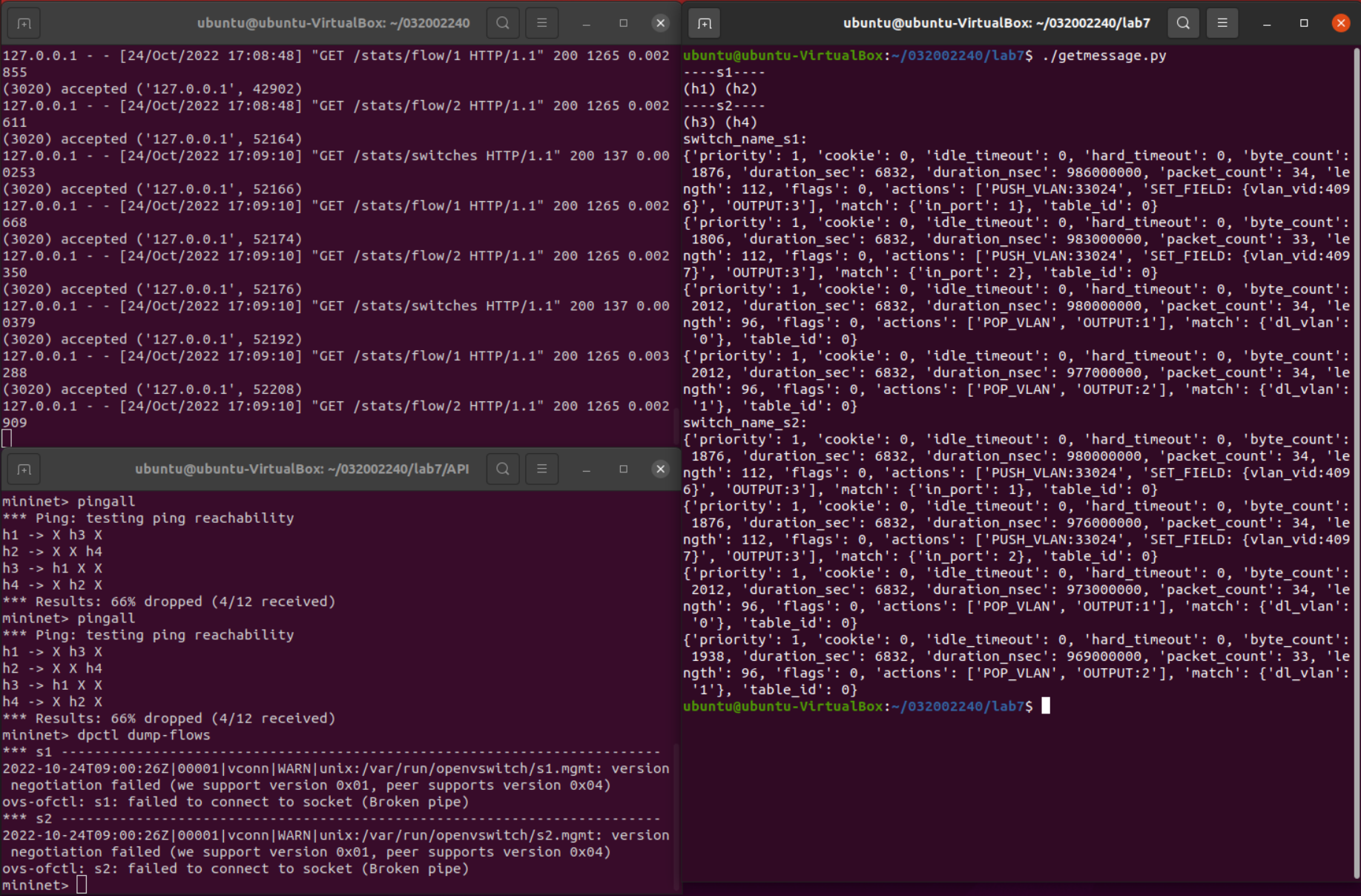实验7:基于REST API的SDN北向应用实践
实验7:基于REST API的SDN北向应用实践
(一)基本要求
1、编写Python程序,调用OpenDaylight的北向接口实现以下功能
(1) 利用Mininet平台搭建下图所示网络拓扑,并连接OpenDaylight;

(2) 下发指令删除s1上的流表数据。
import requests
from requests.auth import HTTPBasicAuth
def http_detele(url):
url = url
headers = {'Content-Type': 'application/json'}
resp = requests.delete(url, headers=headers, auth=HTTPBasicAuth('admin', 'admin'))
return resp
if __name__ == '__main__':
url = 'http://127.0.0.1:8181/restconf/config/opendaylight-inventory:nodes/node/openflow:1/'
resp = http_detele(url)
print(resp.content)

(3) 下发硬超时流表,实现拓扑内主机h1和h3网络中断20s。
//intterupt.py
import requests
from requests.auth import HTTPBasicAuth
if __name__ == "__main__":
url = 'http://127.0.0.1:8181/restconf/config/opendaylight-inventory:nodes/node/openflow:1/flow-node-inventory:table/0/flow/1'
with open("./time.json") as f: #中断规则
jstr = f.read()
headers = {'Content-Type': 'application/json'}
res = requests.put(url, jstr, headers=headers, auth=HTTPBasicAuth('admin', 'admin'))
print (res.content)
//time.json
{
"flow": [
{
"id": "1",
"match": {
"in-port": "1",
"ethernet-match": {
"ethernet-type": {
"type": "0x0800"
}
},
"ipv4-destination": "10.0.0.3/32"
},
"instructions": {
"instruction": [
{
"order": "0",
"apply-actions": {
"action": [
{
"order": "0",
"drop-action": {}
}
]
}
}
]
},
"flow-name": "flow1",
"priority": "65535",
"hard-timeout": "20",
"cookie": "2",
"table_id": "0"
}
]
}

(4) 获取s1上活动的流表数。
//get.py
#!/usr/bin/python
import requests
from requests.auth import HTTPBasicAuth
if __name__ == "__main__":
url = 'http://127.0.0.1:8181/restconf/operational/opendaylight-inventory:nodes/node/openflow:1/flow-node-inventory:table/0/opendaylight-flow-table-statistics:flow-table-statistics'
headers = {'Content-Type': 'application/json'}
res = requests.get(url,headers=headers, auth=HTTPBasicAuth('admin', 'admin'))
print (res.content)

2、编写Python程序,调用Ryu的北向接口实现以下功能

(1) 实现上述OpenDaylight实验拓扑上相同的硬超时流表下发。
//Ryuput.py
#!/usr/bin/python
import requests
if __name__ == "__main__":
url = 'http://127.0.0.1:8080/stats/flowentry/add'
with open("./Ryutimeout.json") as file:
str = file.read()
headers = {'Content-Type': 'application/json'}
res = requests.post(url, str, headers=headers)
print (res.content)
//Ryutimeout.json
{
"dpid": 1,
"cookie": 1,
"cookie_mask": 1,
"table_id": 0,
"hard_timeout": 20,
"priority": 65535,
"flags": 1,
"match":{
"in_port":1
},
"actions":[
]
}

(2) 参考Ryu REST API的文档,基于VLAN实验的网络拓扑,编程实现相同的VLAN配置。(提示:拓扑生成后需连接Ryu,且Ryu应能够提供REST API服务)
建立拓扑:

编写脚本v1.sh:
# 将主机1,2发送来的数据包打上vlan标记
curl -X POST -d '{
"dpid": 1,
"priority": 1,
"match":{
"in_port": 1
},
"actions":[
{
"type": "PUSH_VLAN",
"ethertype": 33024
},
{
"type": "SET_FIELD",
"field": "vlan_vid",
"value": 4096
},
{
"type": "OUTPUT",
"port": 3
}
]
}' http://localhost:8080/stats/flowentry/add
curl -X POST -d '{
"dpid": 1,
"priority": 1,
"match":{
"in_port": 2
},
"actions":[
{
"type": "PUSH_VLAN",
"ethertype": 33024
},
{
"type": "SET_FIELD",
"field": "vlan_vid",
"value": 4097
},
{
"type": "OUTPUT",
"port": 3
}
]
}' http://localhost:8080/stats/flowentry/add
# 将主机3,4发送来的数据包取出vlan标记
curl -X POST -d '{
"dpid": 1,
"priority": 1,
"match":{
"vlan_vid": 0
},
"actions":[
{
"type": "POP_VLAN",
"ethertype": 33024
},
{
"type": "OUTPUT",
"port": 1
}
]
}' http://localhost:8080/stats/flowentry/add
curl -X POST -d '{
"dpid": 1,
"priority": 1,
"match":{
"vlan_vid": 1
},
"actions":[
{
"type": "POP_VLAN",
"ethertype": 33024
},
{
"type": "OUTPUT",
"port": 2
}
]
}' http://localhost:8080/stats/flowentry/add
# 将主机3,4发送来的数据包打上vlan标记
curl -X POST -d '{
"dpid": 2,
"priority": 1,
"match":{
"in_port": 1
},
"actions":[
{
"type": "PUSH_VLAN",
"ethertype": 33024
},
{
"type": "SET_FIELD",
"field": "vlan_vid",
"value": 4096
},
{
"type": "OUTPUT",
"port": 3
}
]
}' http://localhost:8080/stats/flowentry/add
curl -X POST -d '{
"dpid": 2,
"priority": 1,
"match":{
"in_port": 2
},
"actions":[
{
"type": "PUSH_VLAN",
"ethertype": 33024
},
{
"type": "SET_FIELD",
"field": "vlan_vid",
"value": 4097
},
{
"type": "OUTPUT",
"port": 3
}
]
}' http://localhost:8080/stats/flowentry/add
curl -X POST -d '{
"dpid": 2,
"priority": 1,
"match":{
"vlan_vid": 0
},
"actions":[
{
"type": "POP_VLAN",
"ethertype": 33024
},
{
"type": "OUTPUT",
"port": 1
}
]
}' http://localhost:8080/stats/flowentry/add
curl -X POST -d '{
"dpid": 2,
"priority": 1,
"match":{
"vlan_vid": 1
},
"actions":[
{
"type": "POP_VLAN",
"ethertype": 33024
},
{
"type": "OUTPUT",
"port": 2
}
]
}' http://localhost:8080/stats/flowentry/add
删除流表:

运行脚本v1.sh:

(二)进阶要求
OpenDaylight或Ryu任选其一,编程实现查看前序VLAN实验拓扑中所有节点(含交换机、主机)的名称,以及显示每台交换机的所有流表项。
#!/usr/bin/python
import requests
import time
import re
class GetInformation:
def __init__(self, ip):
self.ip = ip
def GetSwitch_id(self):
url = 'http://' + self.ip + '/stats/switches'
re_switch_id = requests.get(url=url).json()
switch_id_hex = []
for i in re_switch_id:
switch_id_hex.append(hex(i))
return switch_id_hex
def GetFlow_table(self):
url = 'http://' + self.ip + '/stats/flow/%d'
list_switch = self.GetSwitch_id()
all_flow = []
for switch in list_switch:
new_url = format(url % int(switch, 16))
re_switch_flow = requests.get(url=new_url).json()
all_flow.append(re_switch_flow)
return all_flow
def ShowFlow(self):
list_flow = self.GetFlow_table()
for flow in list_flow:
for dpid in flow.keys():
dp_id = dpid
print('switch_name_s{1}:'.format(hex(int(dp_id)), int(dp_id)))
for list_table in flow.values():
for table in list_table:
print(table)
def ShowName(self):
list_flow = self.GetFlow_table()
for flow in list_flow:
for dpid in flow.keys():
dp_id = dpid
switchnum= '{1}'.format(hex(int(dp_id)), int(dp_id))
print('----s'+switchnum+'----')
switchnum = int(switchnum)
for list_table in flow.values():
count = 0
for table in list_table:
string1 = str(table)
if re.search("'dl_vlan': '(.*?)'", string1) is not None:
num = re.search("'dl_vlan': '(.*?)'", string1).group(1);
if num == '0' and switchnum == 1:
print('(h1)',end=" ")
if num == '1' and switchnum == 1:
print('(h2)')
if num == '0' and switchnum == 2:
print('(h3)',end=" ")
if num == '1' and switchnum == 2:
print('(h4)')
S1 = GetInformation("127.0.0.1:8080");
S1.ShowName();
S1.ShowFlow();

(三)个人总结
实验难度:
本次实验的基本要求部分难度就有点大了,进阶部分的难度更大一些,同时因为部分知识的遗忘,较为耗费时间和精力,需要对Openflow协议,ryu,opendaylight有较好的理解才能做得下来,且要求代码量较大。
实验过程遇到的困难及解决办法:
- 困难:cucl删除流表命令未安装
解决方法:按照提示直接安装后即可
- 困难:此次实验需要阅读的官方文档较多,比较难以定位到自己需要的内容
解决方法:理解了各个接口的分类依据,再比较自己所需的接口类型,就可以快速地在文档中的文件目录树下搜索到自己需要的接口和所对应的信息
- 困难:调用ryu北向接口时无法成功调用
解决方法:要先开ryu控制器,再进行之后的操作
个人感想:
通过本次实验,加深了对SDN的认识,进一步熟悉了OpenDaylight和ryu的使用,初步尝试了编写程序调用OpenDaylight REST API实现特定网络功能




 浙公网安备 33010602011771号
浙公网安备 33010602011771号